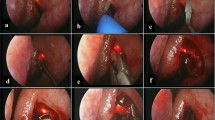Abstract
Endoscopic endonasal dacryocystorhinostomy (EDCR) is an accepted alternative to external dacryocystorhinostomy (DCR) for relieving obstruction of the lacrimal drainage system. Powered and radiowave instruments are useful for the control of bleeding and for wide exposure of the lacrimal sac and canaliculus. In this study, we evaluated the surgical outcome of powered EDCR with radiowave instruments at five obstruction levels: (1) upper and/or lower canaliculi (obstruction was located less than 8 mm from puncta); (2) common canaliculus (obstruction was less than 10 mm from puncta); (3) lacrimal sac; (4) duct-sac junction; and (5) nasolacrimal duct. The overall success rate was 93.6 % (104/111), with 60.0 % (3/5) success for upper and lower canalicular stenosis, 85.0 % (17/20) for common canalicular stenosis, 92.0 % (23/25) for obstruction at the lacrimal sac, 100 % (41/41) for obstruction at the duct-sac junction, and 100 % (20/20) for nasolacrimal duct obstruction. EDCR resulted in a good overall surgical outcome for any obstruction of the lacrimal drainage pathway compared with external DCR. Powered EDCR using radiowave instruments is useful for not only obstruction of the lacrimal sac and duct-sac junction, but also for that of the upper/lower and common canaliculi.


Similar content being viewed by others
References
Leong SC, Macewen CJ, White PS (2010) A systematic review of outcomes after dacryocystorhinostomy in adults. Am J Rhinol Allergy 24:81–90
Metson R, Woog JJ, Puliafito CA (1994) Endoscopic laser dacryocystorhinostomy. Laryngoscope. 104:269–274
Umapathy N, Kalra S, Skinner DW, Dapling RB (2006) Long-term results of endonasal laser dacryocystorhinostomy. Otolaryngol Head Neck Surg 135:81–84
Yung MW, Hardman-Lea S (2002) Analysis of the results of surgical endoscopic dacryocystorhinostomy: effect of the level of obstruction. Br J Ophthalmol 86:792–794
Naraghi M, Tabatabaii Mohammadi SZ, Sontou AF, Farajzadeh Deroee A, Boroojerdi M (2012) Endonasal endoscopic dacryocystorhinostomy: how to achieve optimal results with simple punch technique. Eur Arch Otorhinolaryngol 269:1445–1449
Choi JC, Jin HR, Moon YE, Kim MS, Oh JK, Kim HA, Choi MY, Shim WS (2009) The surgical outcome of endoscopic dacryocystorhinostomy according to the obstruction levels of lacrimal drainage system. Clin Exp Otorhinolaryngol. 2:141–144
Unlu HH, Gunhan K, Baser EF, Songu M (2009) Long-term results in endoscopic dacryocystorhinostomy: is intubation really required? Otolaryngol Head Neck Surg 140:589–595
Özer Ö, Eskiizmir G, Ünlü H, İşisağ A, Aslan A (2012) Chronic inflammation: a poor prognostic factor for endoscopic dacryocystorhinostomy. Eur Arch Otorhinolaryngol 269:839–845
Brewis C, Yung M, Merkonidis C, Hardman-Lea S (2008) Endoscopic dacryocystorhinostomy in functional lacrimal obstruction. J Laryngol Otol 122:921–923
Wormald PJ (2002) Powered endoscopic dacryocystorhinostomy. Laryngoscope 112:69–72
Smirnov G, Tuomilehto H, Teräsvirta M, Nuutinen J, Seppä J (2008) Silicone tubing is not necessary after primary endoscopic dacryocystorhinostomy: a prospective randomized study. Am J Rhinol 22:214–217
Callejas CA, Tewfik MA, Wormald PJ (2010) Powered endoscopic dacryocystorhinostomy with selective stenting. Laryngoscope 120:1449–1452
Saeed BM (2012) Endoscopic DCR without stents: clinical guidelines and procedure. Eur Arch Otorhinolaryngol 269:545–549
Mann BS, Wormald PJ (2006) Endoscopic assessment of the dacryocystorhinostomy ostium after endoscopic surgery. Laryngoscope 116:1172–1174
Conflict of interest
The authors declare that they have no conflict of interest.
Author information
Authors and Affiliations
Corresponding author
Rights and permissions
About this article
Cite this article
Yoshida, N., Kanazawa, H., Shinnabe, A. et al. Powered endoscopic dacryocystorhinostomy with radiowave instruments: surgical outcome according to obstruction level. Eur Arch Otorhinolaryngol 270, 579–584 (2013). https://doi.org/10.1007/s00405-012-2065-9
Received:
Accepted:
Published:
Issue Date:
DOI: https://doi.org/10.1007/s00405-012-2065-9




